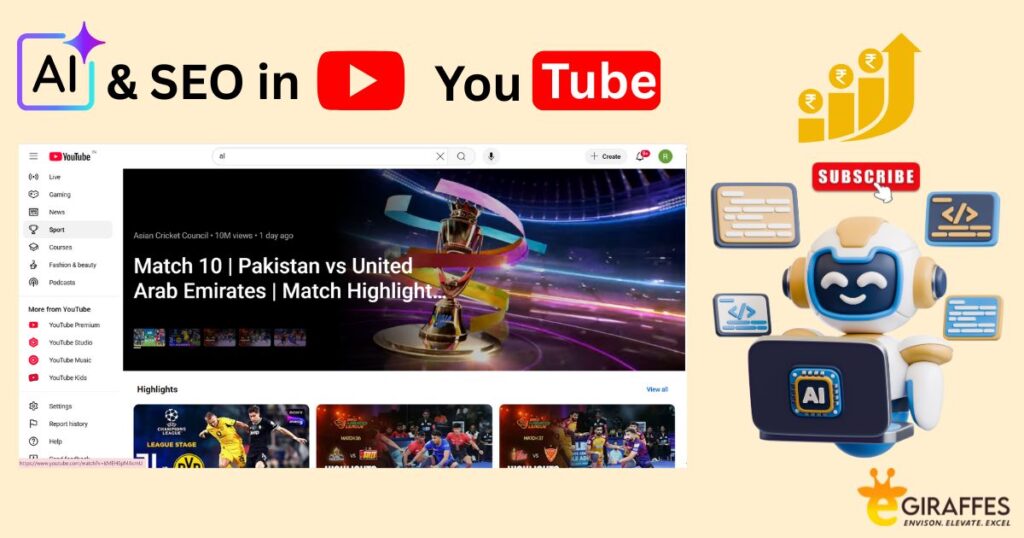AI’s Impact on YouTube SEO: The Future of Video Ranking Explained

Over the past decade, YouTube has evolved from a simple video-sharing platform into the world’s second-largest search engine. Today, it plays a crucial role not only in entertainment but also in education, branding, and digital marketing. As competition intensifies, creators and businesses alike are recognizing that the key to visibility on YouTube lies in mastering YouTube SEO—and Artificial Intelligence (AI) is now at the center of that equation.
The Changing Landscape of YouTube SEO
Traditionally, YouTube SEO was built on a foundation of keywords, tags, and metadata. Titles, descriptions, and tags needed to be optimized with the right phrases to help videos appear in search results. That approach worked when content was less abundant. But today, with over 500 hours of video uploaded every minute, YouTube’s algorithm has had to become more intelligent—and that’s where AI comes in.
Now, optimization goes far beyond keywords. YouTube’s AI-powered systems evaluate content based on how viewers interact with it. Metrics such as watch time, click-through rate, viewer retention, and user engagement carry significant weight in determining a video’s ranking. The shift has moved YouTube SEO from a technical checklist to a dynamic system that rewards high-quality, engaging content.
AI’s Deep Dive into Video Content
AI technology now enables YouTube to analyze video content in ways that were previously unimaginable. It doesn’t rely solely on textual data but interprets visual and audio elements as well. Here’s how:
- Visual Analysis: AI can detect elements within a video frame—such as objects, backgrounds, logos, and even facial expressions. This allows the algorithm to better understand what the video is about, regardless of the title or description.
- Audio Transcription: Spoken words are automatically transcribed and indexed. This means that everything said in your video can influence how it ranks. Keywords no longer have to be manually typed; they can simply be spoken naturally in the script.
- Viewer Behavior Monitoring: AI closely monitors user behavior, such as how long someone watches a video, whether they skip parts, or if they share or like the content. This behavior-driven data has become essential to YouTube SEO.
- Sentiment Recognition: AI can even detect tone and emotion. A video that conveys genuine excitement or clear value to the viewer may be favored in rankings over a dull or irrelevant one.
In essence, AI acts as an evaluator, analyzing every layer of content—not just what’s written but how viewers respond.
Personalized Recommendations and the AI Engine
Another major advancement in YouTube SEO is the personalization of content recommendations. YouTube’s home page, suggested videos, and up-next sections are now powered entirely by AI algorithms that learn from individual viewing habits.
This personalization impacts creators in several key ways:
- Contextual Relevance: Videos are recommended based on what the algorithm predicts a user will find relevant. That means if your content fits a viewer’s interest pattern, it has a better chance of being surfaced—even if it’s not keyword-optimized in the traditional sense.
- Performance Over Perfection: A video with average SEO but high retention and replay value may outrank a perfectly optimized video with low engagement.
For marketers and content creators, understanding this algorithmic behavior opens the door to crafting content that aligns not only with topics of interest but with how users actually interact with videos.
How AI Impacts Video Discovery and Search
AI doesn’t just personalize feeds—it also influences how videos appear in search results. From smart thumbnails to automatic chapters and previews, AI technologies play a pivotal role in improving user experience and shaping visibility.
YouTube’s AI-generated chapters break videos into digestible segments based on content flow, helping both the algorithm and the viewer understand what each part covers. Smart previews encourage more informed clicks, increasing engagement and, in turn, improving rankings.
Furthermore, as AI-driven platforms like Google Search and AI-powered assistants begin to reference YouTube content in their answers, the boundaries of YouTube SEO expand beyond the platform itself. This shift requires creators to think about how their content will perform across multiple AI-integrated environments.
Actionable YouTube SEO Strategies in an AI-Driven World
With AI taking center stage, creators and brands must adapt their strategies. Here are some ways to stay ahead:
- Prioritize Watch Time: Create compelling introductions and keep the content engaging throughout. The longer people stay, the higher your chances of being promoted by the algorithm.
- Use Conversational Language: Because AI scans audio, naturally spoken keywords embedded in the script can improve discoverability without feeling forced.
- Incorporate AI Tools: Leverage platforms like TubeBuddy and VidIQ, which offer AI insights into keywords, competition, and audience behavior.
- Design Data-Driven Thumbnails: Thumbnails should be tested and optimized using AI-based tools that predict click performance based on design elements.
- Test Content Formats: Short-form videos, long-form content, and live streams all interact differently with the algorithm. Experimenting helps identify what format works best for your target audience.
- Maintain Authenticity: AI is becoming better at recognizing authentic versus clickbait content. Videos that offer real value and consistent tone are more likely to perform well over time.
How Businesses Can Leverage YouTube SEO and AI
In today’s content-saturated environment, businesses must go beyond traditional marketing tactics. Utilizing AI insights and intelligent YouTube SEO practices can give brands a real competitive edge. For instance, an SEO Agency in Pune might integrate AI analytics with storytelling to create videos that not only reach the right audience but retain them.
Such agencies can analyze viewer behavior trends, identify high-performing keywords embedded in speech, and build strategies around what the AI algorithm favors—helping local businesses thrive on a global stage.
The Future of YouTube SEO in the AI Era
Looking ahead, it’s clear that AI will continue shaping how content is discovered, ranked, and recommended on YouTube. Some trends on the horizon include:
- Optimization for Voice Search: As voice-controlled assistants gain popularity, videos will need to answer spoken queries effectively.
- Real-Time AI Editing: Tools may soon provide live feedback during editing, suggesting trims, additions, or reordering based on predicted viewer retention.
- Cross-Platform AI Rankings: YouTube videos could become prominent not just on YouTube but across AI-powered search engines and chat interfaces.
- Credibility Scoring: As misinformation grows, AI may increasingly prioritize content from verified and trusted sources.
Final Thoughts
Artificial Intelligence has fundamentally changed how YouTube SEO works. It’s no longer just about inserting the right keywords or writing optimized descriptions. Success now depends on crafting high-quality, engaging content that resonates with real people—and the AI ensures that only the best gets surfaced.
Whether you’re an independent creator, a growing business, or an agency, embracing these AI-driven changes isn’t optional. It’s the path to staying visible, relevant, and ahead of the competition in a constantly evolving digital landscape.



